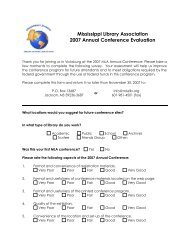Full Text (PDF) - Mississippi Library Association
Full Text (PDF) - Mississippi Library Association
Full Text (PDF) - Mississippi Library Association
You also want an ePaper? Increase the reach of your titles
YUMPU automatically turns print PDFs into web optimized ePapers that Google loves.
<strong>Mississippi</strong> Libraries Vol. 75, No. 1, Spring 2012 Page 39<br />
the blues make up the obvious audience<br />
for this material; however, a companion<br />
CD and DVD of original music and film<br />
should make it appeal to the general reader<br />
as well. I highly recommend this multimedia<br />
experience that is both educational<br />
and entertaining. It is an excellent starting<br />
point in understanding the roots of this<br />
unique genre of music. Give My Poor<br />
Heart Ease is essential for any academic or<br />
public library’s local history collection.<br />
Alisa St. Amant, assistant director, Jackson-George<br />
Regional <strong>Library</strong> System<br />
— ◆ —<br />
Hawkins, Larry. Flags Used by <strong>Mississippi</strong><br />
during the War Between the States.<br />
Memphis, TN: J. Chalmers Pub., 2008.<br />
135 pp. $33.00 (paperback)<br />
Larry Hawkins, author of Flags Used<br />
by <strong>Mississippi</strong> during the War Between<br />
the States, is committed to the study of<br />
<strong>Mississippi</strong> during the Civil War.<br />
Hawkins’s work attempts to fill a void in<br />
<strong>Mississippi</strong> scholarship, which he identifies<br />
as a lack of research on the history of<br />
Civil War flags in <strong>Mississippi</strong>. Although<br />
Hawkins does not claim to be an expert on<br />
this subject, his text is filled with a wealth<br />
of information and as many photographs<br />
of these flags as possible.<br />
Hawkins begins his text with a short<br />
introduction that explains his intent in writing<br />
this book and follows with a short section<br />
on <strong>Mississippi</strong> Civil War history and a<br />
discussion of flags during this time. The<br />
meat of Hawkins’s book consists of five<br />
chapters: <strong>Mississippi</strong> flags in (1) the Army<br />
of Northern Virginia, (2) the Army of Tennessee<br />
and the Western Theater, (3) cavalry<br />
units, (4) artillery units, and (5) other<br />
units. Each chapter is further broken down<br />
into sections describing the flags of individual<br />
infantry units.<br />
These five chapters include many full<br />
color photographs of the flags that are discussed<br />
in the text. The photographs are<br />
essential to the text, as they add a visual<br />
dimension to the author’s descriptions and<br />
allow the reader to truly visualize what<br />
Hawkins is writing. The structure of these<br />
sections is somewhat problematic, however.<br />
Hawkins includes information about<br />
each infantry unit, as well as a history of<br />
each particular flag, a description of the<br />
flag, information about where the flag is<br />
now, details about his sources, and other<br />
miscellaneous facts he has gathered.<br />
While the information provided is valuable,<br />
it is hard to follow. The text reads like a<br />
person’s private notes seemingly written as<br />
the information was uncovered. In addition,<br />
Hawkins chooses not to use footnotes<br />
in his text, causing all of this information to<br />
be lumped together clumsily into paragraphs.<br />
This lack of clear organization<br />
makes it difficult for the reader to digest<br />
the information that is available.<br />
Although this is not an easy read, Flags<br />
Used by <strong>Mississippi</strong> during the War<br />
Between the States would be useful to<br />
anyone interested in <strong>Mississippi</strong> history<br />
and would be a suitable addition to academic<br />
libraries. Hawkins offers a unique<br />
look at flags that may otherwise have<br />
remained overlooked and forgotten.<br />
Alyssa Wilson, senior library assistant,<br />
University of <strong>Mississippi</strong><br />
— ◆ —<br />
Irons, Jenny. Reconstituting Whiteness:<br />
The <strong>Mississippi</strong> State Sovereignty Commission.<br />
Nashville, TN: Vanderbilt University<br />
Press, 2010. 260 pp. $49.95<br />
(hardcover)<br />
In this work, Irons examines the <strong>Mississippi</strong><br />
State Sovereignty Commission<br />
(MSSC) as an example of the racial<br />
process and a construct as it relates to<br />
white identity and the persistence of privilege<br />
and power. Drawing on the records of<br />
the agency, which became available in<br />
1998, she outlines the history of the<br />
MSSC and carefully reviews its role in supporting,<br />
advocating, and defending a statesanctioned<br />
oppositional position to the<br />
Civil Rights Movement from 1956 until<br />
the Commission was dismantled in 1977.<br />
The MSSC and its fellow traveler, the<br />
White Citizens’ Council, were born of a<br />
belief that the Civil Rights Movement was<br />
not a national effort to guarantee rights to<br />
all people regardless of race but was actually<br />
a federal government movement to<br />
infringe on the sovereignty of states. By<br />
painting constitutional amendments as a<br />
conflict between federalizing rights held by<br />
states, as well as not addressing the issues<br />
of economic and political power struggles<br />
and real-life fear, poverty, segregation, and<br />
inadequate educational institutions, the<br />
white power brokers tried to create a<br />
smoke and mirrors reality. The MSSC was<br />
created by a legislative body dominated by<br />
White Citizens’ Council members and<br />
charged with protecting the “state sovereignty”<br />
and the shaky status quo of racial<br />
segregation.<br />
The MSSC is a glaring example of<br />
state-sponsored racism and the effort to<br />
maintain whiteness as an identity endowed<br />
with superior power and achievement.<br />
Because of the MSSC’s institutional status<br />
as a state-funded agency, it operated in a<br />
context which allowed it to shift its policies<br />
and function from a segregation watchdog<br />
toward a more moderate stance of accommodation<br />
and publicity encouraging compliance<br />
with federal laws. Irons says these<br />
“discourses of progress were wed to discourses<br />
of individualism and democracy,<br />
therefore reconstituting white privilege.”<br />
By discussing this agency and the times<br />
that fostered a dangerous but slowly dying<br />
attitude of institutionalized white superiority,<br />
Irons’ work is a significant contribution<br />
to the sociology of race and racial identity.<br />
This book is recommended for academic<br />
libraries and public libraries with a<br />
special interest in <strong>Mississippi</strong> history and<br />
the Civil Rights Movement.<br />
Joyce M. Shaw, head of Gunter <strong>Library</strong>,<br />
University of Southern <strong>Mississippi</strong><br />
— ◆ —<br />
Koch, Kathleen. Rising from Katrina:<br />
How My <strong>Mississippi</strong> Hometown Lost It All<br />
and Found What Mattered. Winston-














